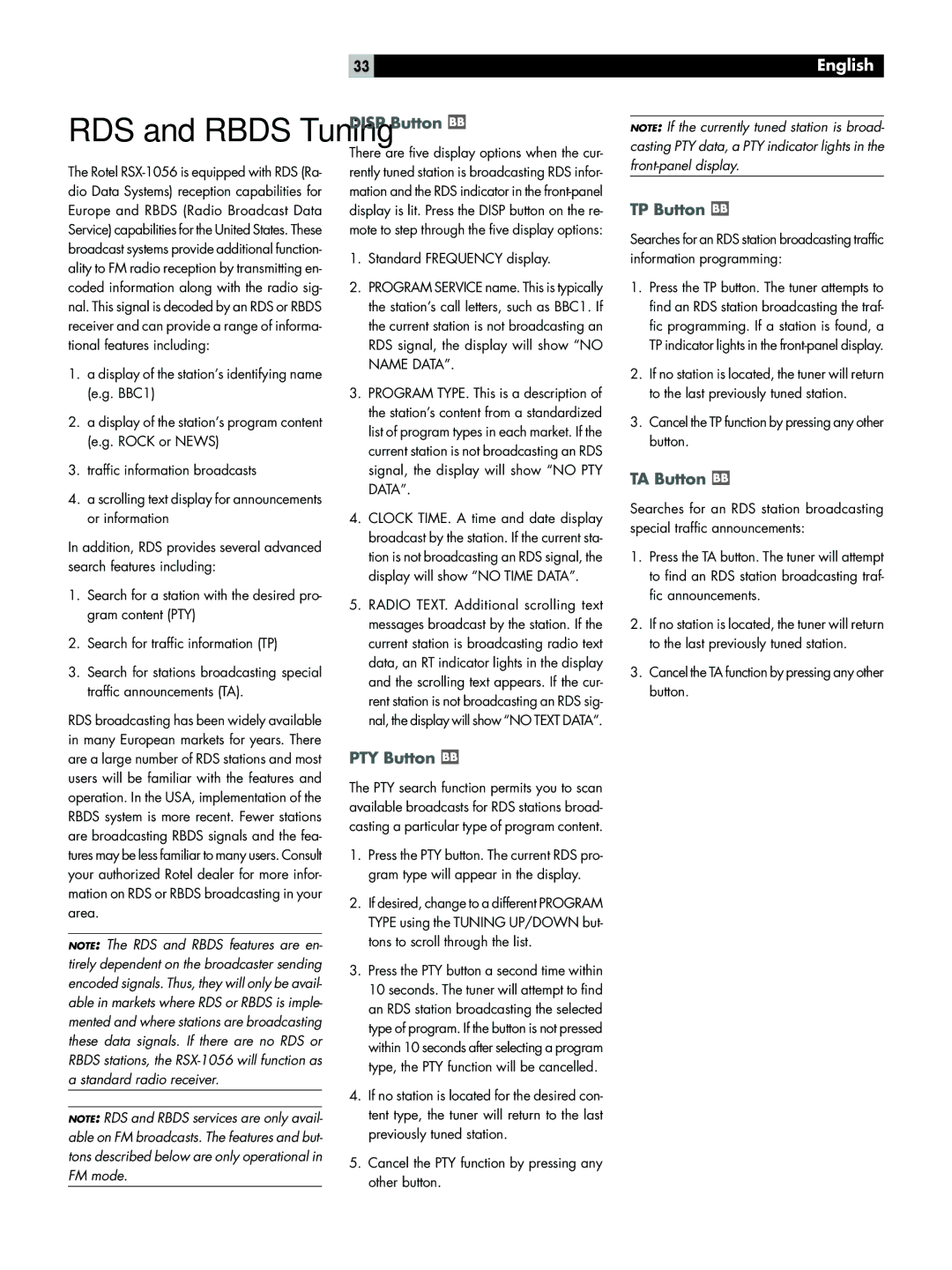
33 | English |
RDS and RBDS Tuning
The Rotel
1.a display of the station’s identifying name (e.g. BBC1)
2.a display of the station’s program content (e.g. ROCK or NEWS)
3.traffic information broadcasts
4.a scrolling text display for announcements or information
In addition, RDS provides several advanced search features including:
1.Search for a station with the desired pro- gram content (PTY)
2.Search for traffic information (TP)
3.Search for stations broadcasting special traffic announcements (TA).
RDS broadcasting has been widely available in many European markets for years. There are a large number of RDS stations and most users will be familiar with the features and operation. In the USA, implementation of the RBDS system is more recent. Fewer stations are broadcasting RBDS signals and the fea- tures may be less familiar to many users. Consult your authorized Rotel dealer for more infor- mation on RDS or RBDS broadcasting in your area.
NOTE: The RDS and RBDS features are en- tirely dependent on the broadcaster sending encoded signals. Thus, they will only be avail- able in markets where RDS or RBDS is imple- mented and where stations are broadcasting these data signals. If there are no RDS or RBDS stations, the
NOTE: RDS and RBDS services are only avail- able on FM broadcasts. The features and but- tons described below are only operational in FM mode.
DISP Button 
There are five display options when the cur- rently tuned station is broadcasting RDS infor- mation and the RDS indicator in the
1.Standard FREQUENCY display.
2.PROGRAM SERVICE name. This is typically the station’s call letters, such as BBC1. If the current station is not broadcasting an RDS signal, the display will show “NO NAME DATA”.
3.PROGRAM TYPE. This is a description of the station’s content from a standardized list of program types in each market. If the current station is not broadcasting an RDS signal, the display will show “NO PTY DATA”.
4.CLOCK TIME. A time and date display broadcast by the station. If the current sta- tion is not broadcasting an RDS signal, the display will show “NO TIME DATA”.
5.RADIO TEXT. Additional scrolling text messages broadcast by the station. If the current station is broadcasting radio text data, an RT indicator lights in the display and the scrolling text appears. If the cur- rent station is not broadcasting an RDS sig- nal, the display will show “NO TEXT DATA”.
PTY Button 
The PTY search function permits you to scan available broadcasts for RDS stations broad- casting a particular type of program content.
1.Press the PTY button. The current RDS pro- gram type will appear in the display.
2.If desired, change to a different PROGRAM TYPE using the TUNING UP/DOWN but- tons to scroll through the list.
3.Press the PTY button a second time within 10 seconds. The tuner will attempt to find an RDS station broadcasting the selected type of program. If the button is not pressed within 10 seconds after selecting a program type, the PTY function will be cancelled.
4.If no station is located for the desired con- tent type, the tuner will return to the last previously tuned station.
5.Cancel the PTY function by pressing any other button.
NOTE: If the currently tuned station is broad- casting PTY data, a PTY indicator lights in the
TP Button 
Searches for an RDS station broadcasting traffic information programming:
1.Press the TP button. The tuner attempts to find an RDS station broadcasting the traf- fic programming. If a station is found, a TP indicator lights in the
2.If no station is located, the tuner will return to the last previously tuned station.
3.Cancel the TP function by pressing any other button.
TA Button 
Searches for an RDS station broadcasting special traffic announcements:
1.Press the TA button. The tuner will attempt to find an RDS station broadcasting traf- fic announcements.
2.If no station is located, the tuner will return to the last previously tuned station.
3.Cancel the TA function by pressing any other button.
